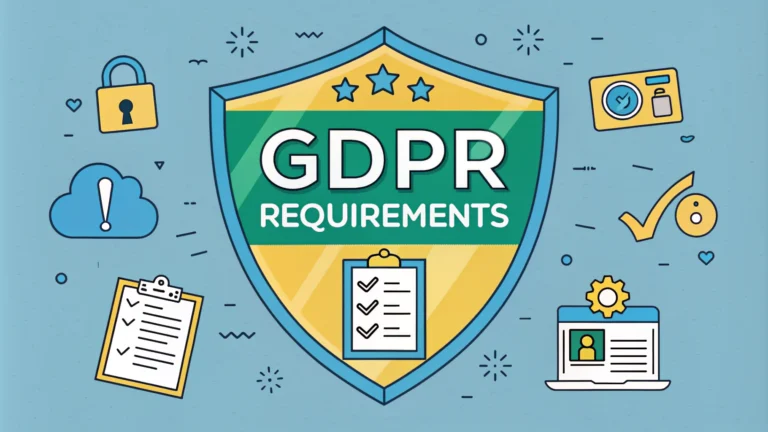GDPR compliance requires organizations to regularly assess and validate their security measures through penetration testing.
Security testing helps identify vulnerabilities before malicious actors can exploit them, protecting personal data as mandated by GDPR Article 32.
This guide explains the key requirements and best practices for GDPR-compliant penetration testing.
Essential GDPR Requirements for Penetration Testing
- Regular security assessments and testing (Article 32)
- Documentation of all testing procedures and results
- Risk-based approach to security testing
- Testing of technical and organizational measures
- Validation of data protection by design principles
Required Testing Scope
Testing must cover all systems processing personal data:
- Web applications and APIs
- Mobile applications
- Network infrastructure
- Database systems
- Cloud services and storage
- Authentication mechanisms
- Access control systems
Testing Frequency Requirements
| Risk Level | Recommended Testing Frequency |
|---|---|
| High | Every 3-6 months |
| Medium | Every 6-12 months |
| Low | Annually |
Documentation Requirements
- Detailed test plans and methodologies
- Scope and objectives of testing
- Testing results and findings
- Risk assessment outcomes
- Remediation plans and timelines
- Evidence of implemented fixes
Tester Qualifications
GDPR requires testing to be performed by qualified professionals with:
- Relevant security certifications (OSCP, CEH, CREST)
- Experience with GDPR compliance requirements
- Understanding of data protection principles
- Knowledge of current security threats and vulnerabilities
Reporting and Follow-up Actions
- Document all identified vulnerabilities
- Classify findings by risk level
- Establish clear remediation timelines
- Track and verify fixes
- Update security documentation
- Report relevant findings to DPO
Getting Started with GDPR Penetration Testing
Contact certified penetration testing providers:
- CREST: www.crest-approved.org
- NCSC: www.ncsc.gov.uk
- SANS Institute: www.sans.org
Testing Best Practices
- Follow industry-standard testing methodologies (OWASP, NIST)
- Use both automated and manual testing approaches
- Conduct testing in staging environments when possible
- Implement security controls to protect test data
- Maintain strict access controls during testing
Incident Response Integration
Testing should align with incident response procedures:
- Document discovered vulnerabilities immediately
- Establish clear communication channels
- Define escalation procedures for critical findings
- Test incident response capabilities
- Validate breach notification processes
Common Testing Challenges
Technical Challenges
- Complex system architectures
- Legacy system limitations
- Cloud infrastructure complexity
- Third-party integration risks
Organizational Challenges
- Resource constraints
- Scheduling limitations
- Stakeholder coordination
- Budget restrictions
Ensuring Long-term GDPR Security Compliance
Maintain continuous compliance through:
- Regular review of testing procedures
- Updates to security policies and controls
- Ongoing staff training and awareness
- Monitoring of emerging threats
- Integration with overall security strategy
- Periodic assessment of testing effectiveness
Strengthening Your Data Protection Framework
- Integrate penetration testing into broader security strategy
- Maintain detailed compliance documentation
- Review and update testing scope regularly
- Invest in security team training
- Stay informed about GDPR updates and requirements
- Build a culture of continuous security improvement
FAQs
- What are the GDPR requirements for penetration testing?
Under GDPR, penetration testing must be conducted with proper authorization, documented procedures, data protection measures in place, and clear scope definition. Testing activities must respect data minimization principles and maintain confidentiality of any personal data encountered. - Do I need data subject consent before conducting penetration tests under GDPR?
No explicit consent is required from individual data subjects, but you must have legitimate grounds for testing, proper authorization from the data controller, and ensure testing is conducted under Article 32’s security requirements. - What documentation is required for GDPR-compliant penetration testing?
Required documentation includes test authorization, scope definition, risk assessments, testing methodology, incident response procedures, data handling protocols, and detailed reports of findings and remediation measures. - How should personal data discovered during penetration testing be handled?
Personal data encountered during testing must be treated confidentially, accessed only when necessary, not extracted unless required, documented in reports securely, and deleted once testing is complete. - What restrictions apply to penetration testing of systems containing special category data?
Systems containing special category data require enhanced security measures, specific documentation of necessity, strict access controls, and additional safeguards to prevent unauthorized access or disclosure during testing. - How should penetration testing results be reported under GDPR?
Reports must be securely stored, contain only necessary personal data, be accessible only to authorized personnel, and include clear documentation of vulnerabilities and recommended security measures in accordance with Article 32. - What are the requirements for third-party penetration testers under GDPR?
Third-party testers must sign data processing agreements, demonstrate GDPR compliance, maintain confidentiality, follow documented security procedures, and provide guarantees of technical and organizational measures. - How often should penetration testing be conducted to maintain GDPR compliance?
GDPR doesn’t specify frequency but requires regular testing of security measures. Best practice suggests annual testing or after significant system changes, with frequency based on risk assessment and data sensitivity. - What are the consequences of non-compliant penetration testing under GDPR?
Non-compliant testing can result in fines up to ���20 million or 4% of global annual turnover, legal liability for data breaches, and regulatory investigations. - How should test data be anonymized for GDPR compliance?
Test data should be pseudonymized or anonymized where possible, with synthetic data used when practical. Any production data must be protected with appropriate security controls and minimized.







